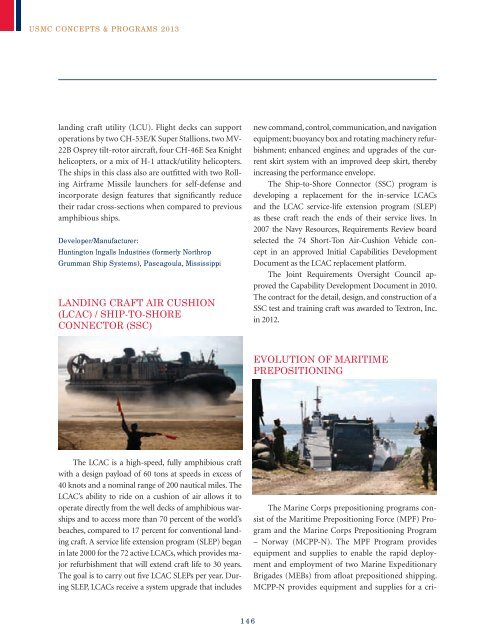USMC Concepts & Programs 2013 - Defense Innovation Marketplace
USMC Concepts & Programs 2013 - Defense Innovation Marketplace
USMC Concepts & Programs 2013 - Defense Innovation Marketplace
Create successful ePaper yourself
Turn your PDF publications into a flip-book with our unique Google optimized e-Paper software.
<strong>USMC</strong> <strong>Concepts</strong> & <strong>Programs</strong> <strong>2013</strong><br />
landing craft utility (LCU). Flight decks can support<br />
operations by two CH-53E/K Super Stallions, two MV-<br />
22B Osprey tilt-rotor aircraft, four CH-46E Sea Knight<br />
helicopters, or a mix of H-1 attack/utility helicopters.<br />
The ships in this class also are outfitted with two Rolling<br />
Airframe Missile launchers for self-defense and<br />
incorporate design features that significantly reduce<br />
their radar cross-sections when compared to previous<br />
amphibious ships.<br />
Developer/Manufacturer:<br />
Huntington Ingalls Industries (formerly Northrop<br />
Grumman Ship Systems), Pascagoula, Mississippi<br />
LANDING CRAFT AIR CUSHION<br />
(LCAC) / SHIP-TO-SHORE<br />
CONNECTOR (SSC)<br />
new command, control, communication, and navigation<br />
equipment; buoyancy box and rotating machinery refurbishment;<br />
enhanced engines; and upgrades of the current<br />
skirt system with an improved deep skirt, thereby<br />
increasing the performance envelope.<br />
The Ship-to-Shore Connector (SSC) program is<br />
developing a replacement for the in-service LCACs<br />
and the LCAC service-life extension program (SLEP)<br />
as these craft reach the ends of their service lives. In<br />
2007 the Navy Resources, Requirements Review board<br />
selected the 74 Short-Ton Air-Cushion Vehicle concept<br />
in an approved Initial Capabilities Development<br />
Document as the LCAC replacement platform.<br />
The Joint Requirements Oversight Council approved<br />
the Capability Development Document in 2010.<br />
The contract for the detail, design, and construction of a<br />
SSC test and training craft was awarded to Textron, Inc.<br />
in 2012.<br />
EVOLUTION OF MARITIME<br />
PREPOSITIONING<br />
The LCAC is a high-speed, fully amphibious craft<br />
with a design payload of 60 tons at speeds in excess of<br />
40 knots and a nominal range of 200 nautical miles. The<br />
LCAC’s ability to ride on a cushion of air allows it to<br />
operate directly from the well decks of amphibious warships<br />
and to access more than 70 percent of the world’s<br />
beaches, compared to 17 percent for conventional landing<br />
craft. A service life extension program (SLEP) began<br />
in late 2000 for the 72 active LCACs, which provides major<br />
refurbishment that will extend craft life to 30 years.<br />
The goal is to carry out five LCAC SLEPs per year. During<br />
SLEP, LCACs receive a system upgrade that includes<br />
The Marine Corps prepositioning programs consist<br />
of the Maritime Prepositioning Force (MPF) Program<br />
and the Marine Corps Prepositioning Program<br />
– Norway (MCPP-N). The MPF Program provides<br />
equipment and supplies to enable the rapid deployment<br />
and employment of two Marine Expeditionary<br />
Brigades (MEBs) from afloat prepositioned shipping.<br />
MCPP-N provides equipment and supplies for a cri-<br />
146

















